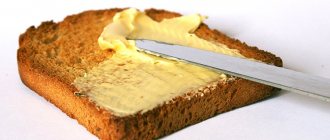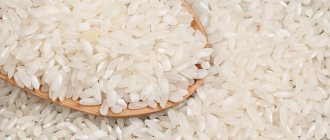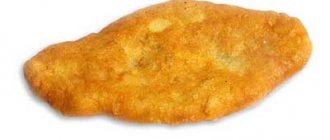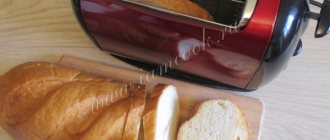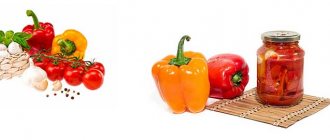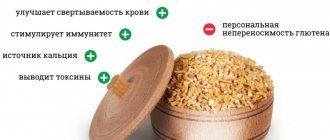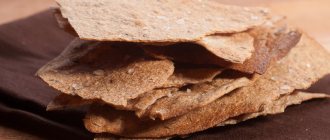For thousands of years, humanity has treated bread as a source of strength, health, and prosperity. But since the beginning of the eighties of the last century, people more often associate problems of overweight or obesity, leading to serious diseases, with the consumption of high-calorie products.
Statistics record sad facts: overweight and obesity have reached global epidemic proportions. Doctors sounded the alarm, and ardent supporters of a healthy diet added all bakery products to the list of “harmful” foods due to their highest calorie content. But the reason for the continuous increase in the number of overweight people does not lie in the calorie content of bread: it is multifaceted.
Don’t rush to exclude baked goods from your diet when thinking about diets. You might as well give up many high-calorie foods! Let's figure it out.
Types of bread: features and calorie composition
To understand how many calories are in bread, to determine for yourself the rate of its consumption, you need to find out what is included in the baked goods, what type of flour was used in it . To a large extent, the change in the calorie content of a product is also influenced by the technology of its preparation .
The table below shows the most common types of baked goods and indicates the calorie content per 100 g of product:
| Type of bread | Calories per 100 g | Proteins fats carbohydrates |
| Rye | 250 | 13/ 3/ 40 |
| Yeast-free | 236 | 7,9/ 1/ 47,6 |
| Whole grain rye flour with malt | 198 | 7,8/ 1/ 39,6 |
| Grey | 227 | 7,5/ 1,3/ 45,2 |
| Darnitsky | 206 | 6,6/ 1,1/ 41 |
| Borodinsky | 208 | 6,9/ 1,3/ 40,9 |
| Molded from rye flour | 217 | 5,9/ 1,1/ 44,5 |
| Wheat-rye (“Ukrainian”) | 198 | 6,6/ 1,2/ 39,6 |
| With bran from wheat flour | 252 | 9,6/ 2,7/ 47,1 |
| Wheat, made from premium flour | 242 | 8,1/ 1/ 48,8 |
| Whole grain (Capital) | 210 | 7/ 1,2/ 45,8 |
Starch is a complex polysaccharide, a carbohydrate, which, when in excess in the body, forms adipose tissue.
The benefits and calorie content of baked goods can only be judged by taking into account the biochemical content of flour. Grain, according to modern standards, is cleaned from the outer shell, which contains the most valuable fiber, rich in vitamins and minerals responsible for a balanced metabolism in the body. The inner part of the grain (kernel) consists of starch and nitrogenous compounds - a soft, mealy core.
Expensive premium wheat flour contains starch and nitrogenous compounds, which make excellent baked goods, but in fact, first grade flour, coarsely ground, containing bran, is of greater value in dietary nutrition than finely ground wheat flour without impurities (bran).
Wheat bread with added bran, containing more calories, is a more valuable and balanced product, since fiber (the hard shell of the grain) regulates the digestion process. The variety of breads containing different ratios of rye, bran and wheat flour also matters when counting calories, as does the type of wheat from which the flour is made.
Perhaps our ancestors did not gain weight because they baked bread from whole grain flour, since they did not know the technologies that brought flour to a refined state.
A complete refusal of the product is unlikely to get rid of extra pounds. Rather, it’s the other way around: a ban causes internal protest, and creating psychological dissonance does not contribute to achieving results—you can’t fool nature.
Understanding the essence of the problem is the beginning of overcoming it. Therefore, we will consider the most compelling reasons leading to excess weight. The truth is in the middle.
Psychological and social aspects
The high calorie content of bread contributes to the accumulation of energy in the body, which, in the absence of physical activity, accumulates under the skin in the form of “strategic reserves” in case of power outages.
This is not a joke, but a law of nature, with which it is useless to argue: instincts, conditioned, unconditioned reflexes exist and continue to work, despite the excessive self-confidence of people who consider themselves its creators.
Since the mid-twentieth century, external factors have changed dramatically: in the struggle for survival, man has created a comfortable living environment for himself, and has put technological progress at the service, eliminating the need for hard physical labor for his own survival. But, having obtained the “easy bread”, people did not find the ideal formula for combining molecular technologies with the genetic code given by nature for the survival of humanity as a biological species.
Since people learned to hunt and domesticated animals, meat and butter were available only to the nobility.
Bread remains the most accessible product for all social groups in all countries of the world.
The predominance of flour products in the people's diet has become an acquired instinct, which is triggered even now, in cases of unstable financial situation in an individual family or even on a national scale during periods of economic crisis.
The thousand-year habit of saturating the body with the most high-calorie, available food has been preserved on a subconscious level. Fresh bread crust in combination with your favorite, equally high-calorie delicacies triggers the mechanism of natural instinct, and the sandwich overshadows thoughts about the fight against excess weight.
Remember that food is primarily a source of energy, not pleasure. Energy expenditure should correspond to the total number of calories consumed, including bread.
Bread and exercise
Modern technologies have taught people that there is no need to get food through hard work - just press a few buttons, order a hamburger or pizza directly to the office, without breaking away from monotonous work that does not require physical effort. The same situation is repeated at home, after a working day: snacks in front of the TV screen often also consist of foods high in calories.
You can talk about the “harm of bread” for your figure, look for “unique diets.”
There is no guarantee that “overeating on proteins”, buying more expensive products, will easily cope with excess weight, leading a sedentary lifestyle. We suggest reading an article that contains tips on how to lose weight without dieting.
Compound
As you can see from the list above, the main ingredients are bread and water. To give the loaf its shape, yeast is added to the composition, thanks to which the structure becomes porous, and the loaf itself becomes lush and voluminous. Also, in many types of loaves, the use of salt, spices, seeds and salt is mandatory. When adding a roll to their diet, people who watch their figure often ask questions about the content - how much protein is in white bread, whether it contains vitamins and microelements.
The benefits of the product depend on its composition. Let's highlight each of the ingredients:
- Refined flour . When making white bread, a special product is used from which “ballast elements” have been removed. But at first glance they are not needed. It is the separated part that contains the largest amount of vitamins and microelements. The first thing that is removed during the purification process is the germ, which is considered the most useful element (it contains tocopherol and a number of other vital elements). The reason why the germ is removed is its short lifespan, which is why the finished product quickly deteriorates. At the next stage, the bran is removed - the shell of the plant, which is considered the main supplier of fiber. It also contains mineral elements and B vitamins. At the final stage of processing, the aleurone grain layer is removed, which contains the most valuable protein for the body (globulins and albumins). That is why, when asked about the nutrients in bread (how much protein, for example), many nutritionists shrug their shoulders - there is almost none there. What remains is pure starch, excessive consumption of which leads to excess weight gain. As for vital elements, they are removed at the purification stage.
- Nutritional supplements . The main task of the seller and manufacturer is to sell the product. To extend the lifespan, preservatives are added to bread, namely sorbic acid, which is characterized by increased resistance to yeast. In addition, almost all manufacturers include flavorings and food coloring. Proper grain storage is key to the quality of bread. In practice, this is an expensive pleasure, so the product is stored without complying with the required standards, and over time it deteriorates and rots. Such grain is cheaper for the manufacturer, so he buys it and adds improvers, as well as other additives - antioxidants and anti-caking agents. But even this is not all. Before making bread, flour is bleached using a group of chemicals - benzene and calcium peroxide, chloride dioxide and others. Few people know, but many of the elements are used in the manufacture of household chemicals. A number of manufacturers go even further - they tint the flour with titanium oxide, which is hazardous to health. Experienced bakers claim that the only “safe” white bread is a brick with a flat top. All other types of product contain improvers that enhance the effect of gluten. Confectionery products mostly consist of 30-50% of such additives. Moreover, the final product has nothing to do with substances beneficial to the body.
- Vegetable oils . It is no secret that the oil contains Omega-3 fats and vitamins that are beneficial for the body. But when heated, the opposite situation occurs - carcinogens are formed that poison the body.
- Milk and eggs . Healthy products are added to some types of loaf, including milk and eggs. But not everything is smooth here either. Experts working in this field talk about the presence of antibiotics and hormones in the ingredients. It is possible to eliminate the danger only if you use country milk and eggs for cooking.
- Salt . Adding salt to bread is not only due to the desire to add flavor to the product. It is this ingredient that prevents the softening of gluten and prevents deterioration of elasticity and weakening of the dough. For this reason, a large amount of salt is often added to the loaf, especially when low-quality or stale flour is used for production. In practice, making bread without salting is possible, but the highest quality flour must be used.
Calorie content in a loaf and a piece of bread
Since all types of bread have different composition and weight, it is difficult to give a definite answer about the number of calories contained in one loaf. But determining its calorie content yourself, by arithmetic calculations, is not difficult. To do this, you need to know the type of baked goods and its exact weight, and then use the formula to calculate: from the calorie table, take the number of calories per 100 g and multiply it by the number of grams in the loaf. For example:
- Wheat bread weighing 600 g contains 242 kcal per 100 g, that is, 6 * 242 = 1452 kcal are needed;
- A loaf of Borodinsky weighing 350 g – 728 kcal (3.5 * 208).
So, knowing the calorie content and weight of the loaf, you can find out the weight of one piece and calculate the number of calories in it. On average, a piece of white bread weighs about 25 g, black - 35 g, a loaf - 20 g, and the thickness does not exceed 0.5 cm. To calculate, you need to cut the loaf into approximately equal slices and divide the total weight by the number of resulting pieces, and then calculate calorie content
For example:
- If you cut a 500g loaf of white bread into 18 pieces, each piece will contain approximately 67 kcal ((5*242)/18);
- A slice weighing 35 g, cut from a Borodinsky loaf (350 g), has 72.8 kcal.
Sandwiches: calorie supplements
Sandwiches, hamburgers, hot and cold sandwiches with various toppings are favorite snack options. But when a person goes on a diet, one must categorically refuse “fast food”, given the high calorie content of bread and the no less calorie content of additives. If you like to eat from McDonald's, then we suggest reading about the calorie content of McDonald's products, about safe and unhealthy foods.
On average, one sandwich with additives accounts for 150-400 kcal.
If the daily calorie intake is 2000 kcal (depending on a person’s individual parameters), and for those losing weight this volume is half as much. Tempted by one sandwich with butter, sausage and cheese, the man ate about a quarter of his daily requirement. At the same time, a piece of bread with a few other ingredients is clearly not enough: a snack on the run satisfies the feeling of hunger for only a couple of hours.
This is precisely the root cause of excluding sandwiches from a healthy diet.
Those who cannot imagine a lunch break at work without a couple of sandwiches need to pay attention to supplements with the optimal amount of calories and include them in their diet. Calculation of the calorie content of a product can be carried out according to the same principle as with bread: the total number of calories in the additive is divided by the number of pieces of sausage, butter, cheese, etc.
The table below reflects the list of the most common sandwich additives and calorie content per piece:
| Name | Weight | Calories |
| Oil | 4 | 30 |
| Boiled sausage | 36 | 170 |
| Ham | 28 | 84 |
| Salami | 10 | 58 |
| Smoked sausage | 9 | 36 |
| Cheese | 18 | 62 |
| Brynza | 31 | 77 |
| Processed cheese | 18 | 59 |
| Mayonnaise | 5 | 31 |
| Honey | 22 | 84 |
| Fish | 53 | 148 |
| Red caviar | 10 | 102 |
To reduce the number of calories in a sandwich, use bread substitutes and as many fresh vegetables as possible instead of fatty foods.
Very often sandwiches help us out on the road, but this is not the only food that you can take with you. We recommend our article: what to take on the road.
Energy value
To get rid of excess weight and stay in good physical shape, you don’t have to go on a diet with a meager diet. It is enough to monitor the number of calories consumed and expended. Do not give up bread if without it your nutrition will seem incomplete and every meal will seem incomplete. After all, this can provoke psychological discomfort, which will negatively affect health. You just need to determine the optimal amount of calories and follow this norm.
Rating of food delivery for weight loss
Delivery of food with calculated calorie content, ready-made diets. No more cooking and counting calories!
Go
Go
Calorie content of crackers and fried bread
Rusks are very often used as an addition to hot liquid dishes and salads. Recommendations for their inclusion in a healthy diet are associated with the content of a large amount of nutrients and vitamins (magnesium, phosphorus, iron, potassium, sodium, etc.), as well as a low level of gluten, which helps normalize the functions of the digestive tract.
Since drying occurs without any additives, the calorie content of crackers is practically no different from the calorie content of the bread from which they are made.
Per 100 g of product of different varieties there are:
- 331 kcal – loaf;
- 210 kcal – black bread;
- 395 kcal – breadcrumbs;
- 180 kcal – rye bread;
- 410 kcal – crackers with raisins;
- 230 kcal – gray bread.
Croutons, like biscuits with bread, are a good base for snacks and sandwiches. Fried crispy bread supplies the body with a lot of carbohydrates, zinc, phosphorus, copper, potassium, calcium, vitamins PP and B, as well as saturated and polyunsaturated acids. The calorie content of croutons directly depends on the type of bread and the additive on which it is fried. When using 3 g of butter (23 kcal) and a piece of black bread (73 kcal), the snack will add 96 kcal. On average, 100 g of croutons can contain up to 407 kcal.
Benefits and harms
The benefits and harms of bread are determined by several criteria:
- the type of flour used;
- additives that increase shelf life and improve appearance;
- the caloric content and energy value of the product is determined by the technological process, starting with the preparation of products and ending with the packaging of finished loaves;
- compliance with consumption standards, nutritional culture;
- characteristics of the body.
Many experts agree that the leaders in the list of flour products of dietary value are products made from wholemeal rye flour and whole wheat flour, as well as bran and whole grain bread. According to research, these varieties have the maximum amount of essential microelements. Why? The process of processing raw materials for the production of flour involves preserving in the final product the proportion of sprouted grains that have the greatest benefit.
Photo: 8fit.com
Wheat bread, which for centuries was considered a privileged food, today is considered a “harmful” product. Dietary baked goods now include products with a 20% grain husk content. Bread made from wholemeal wheat flour with bran quickly and for a long time saturates the body and normalizes intestinal function. Since it contains “slow carbohydrates”, which are absorbed by the body gradually, without being stored in reserve in the form of fatty tissue.
It is also not recommended to overuse yeast. They destroy the beneficial substances in the product and cause dysbacteriosis by reacting with flour carbohydrates even at the dough kneading stage.
When choosing dietary bread, pay more attention to yeast-free dough (lavash, unleavened flatbread) or to products prepared with sourdough.
We invite you to watch a video on the topic of yeast and “yeast-free bread” from the “Live Healthy” program.
Try to carefully study the composition of the product indicated on the label. Some types of baked goods contain margarine, which supplies the body with large amounts of harmful trans fats and chemical additives. Such baking causes an imbalance in the digestion process.
We invite you to watch a video from the Live Healthy program about margarine and butter.
To better manage your calorie content, bake your bread at home.
The table below will help you understand which bread contains more nutrients and what its energy value is:
| Rye | White | Black |
| Squirrels | ||
| 8.5 g | 7.6 g | 1.72 g |
| Fats | ||
| 3.3 g | 3.2 g | 0.31 g |
| Carbohydrates | ||
| 48.3 g | 50.8 g | 11.29 g |
| Cellulose | ||
| 5.8 g | 2.4 g | 2.8 g |
| Calcium | ||
| 24 mg | 33 mg | 35 mg |
| Potassium | ||
| 166 mg | 100 mg | 74 mg |
| Sodium | ||
| 660 mg | 681 mg | 49 mg |
By the way, if you want to know which bread is better, white or black, we suggest watching a video on this topic.
Crispbread for weight loss
There are not very many calories in a piece of bread, but when dieting you have to limit yourself in the amount of this product. Currently, many people are abandoning traditional bread altogether in favor of grain bread.
Crisps for weight loss are recommended by many nutritionists. This especially applies to whole grain varieties. The breads do not contain sugar or yeast, which makes them somewhat healthier than traditional bread.
There are actually even more calories in bread than in white or brown bread. On average, bread has an energy value of about 300 kilocalories. In order for the product to bring benefits and not extra pounds, you need to limit the consumption of bread to 50 grams per day. Crisps for weight loss should be purchased from whole grains with the addition of bran. You also need to eat such bread in quantities of up to 50 grams per day. Calories in bread are present due to the presence of a large amount of complex carbohydrates. These substances help a person who is losing weight not to experience constant hunger and maintain good health while dieting.
Eating bread on a diet
Bread also contains other useful substances, the presence of which directly depends on the type of product.
The common belief that bread is a “forbidden fruit” on a diet is wrong. If you want to lose weight, be careful when consuming baked goods. To consolidate your results, follow these rules:
- Limit consumption to 50 g (2 pieces) per day.
- Avoid sandwiches with high-calorie additives containing large amounts of fast carbohydrates; do not eat bread with potatoes, rice, pasta, cereals, butter or vegetable oil.
- Give preference to healthy flour products.
- You can eat bread during the day, during meals or separately, but not after 8 pm or 4 hours before bedtime.
- Do not eat hot baked goods, as they contain high gluten content, which makes it difficult to digest food.
We recommend reading the following articles: Balanced nutrition Protein-carbohydrate alternation (BCA) Benefits and harms of apples Calorie content of eggs Benefits and harms of banana Calorie content of rice
Let us separately clarify what kind of bread you should eat in order not to gain weight. Dietary flour products include products containing a low glycemic index, which determines the effect of food on blood sugar levels. Thus, sweet additives and raising agents in combination with premium wheat flour significantly increase the glycemic index, so those losing weight should avoid products that contain these ingredients.
It is recommended to include the following types of bread in your diet:
- Bran. Causes rapid saturation due to the swelling of bran in the stomach, removes waste and toxins from the body. It has a low glycemic index and a high content of vitamins and minerals.
- Wholegrain . Baked goods made from wholemeal white flour extracted from sprouted grains retain vitamins after processing and contain complex carbohydrates that promote satiety. Reduces cholesterol levels.
- Rye. Contains a lot of magnesium, phosphorus, iron and vitamins. Thanks to the large amount of fiber, it normalizes the functioning of the gastrointestinal tract and improves food absorption.
- Wheat grain. The presence of coarse fibers normalizes intestinal function. But the higher carbohydrate content in wheat grains results in a high calorie content of the product.
- Alive. Its benefit lies in the need for a large amount of energy during digestion. The composition includes essential amino acids and microelements.
- Biobread. Preparation involves the use of several types of wholemeal flour and natural sourdough without the addition of raising agents, flavorings, preservatives and flavor enhancers.
- Salt-free or achloride bread. The dough is prepared using whey.
- Buckwheat. A low-calorie and high-carbohydrate product, it is rich in vitamins and minerals that remain in the buckwheat bread.
From this video from the program “Live Healthy!” find out whether or not you can eat bread. The special guest of the program is nutritionist, nutrition specialist, researcher, author of the “bread diet” and the nutritional bestseller “Eat Bread and Lose Weight,” Olga Raz.
How to eat baked goods while on a diet
During a diet, the main rule is not to overuse baked goods. A couple of slices of bread during the day will not harm your figure. And if it is healthy bran bread or yeast-free bread, it will even benefit the entire body.
If it is difficult to give up white bread while on a diet, then it is best to eat it in the morning. Breakfast is quickly digested and is not stored in the form of fat folds on the waist. In this case, it is better to refrain from eating bread in the evening.
Alternative to bread for losing weight
Bread is popular among people trying to lose weight. They contain iron, calcium, protein and fiber, which are beneficial for the body. Thus, 100-150 g of bread contains the daily intake of fiber, which accelerates the elimination of toxins and waste. But breads have different compositions, and some of them are high in calories and do not contribute to weight loss. Products suitable for diet are prepared by extrusion from peeled or whole grain flour without the use of yeast. Some breads add flax or sesame seeds, which are also good for the body.
Let's compare several popular types:
| Name | Number of kcal. per 100 g | Compound |
| Rye | 360 | wheat bran, margarine, rye flour, yeast, salt. |
| Wheat | 240 | sprouted wheat grains, additives: raisins or dried apricots. Rich in magnesium and potassium. |
| Multigrain | 290 | buckwheat, rice, corn, oatmeal, wheat. |
| Wheat-rye | 310 | wheat and rye flour, water, seeds. They contain a lot of sodium, magnesium, phosphorus, iron, calcium, fiber, vitamins PP, B, E. |
| Wheat-oat | 302 | oatmeal, winter wheat, table salt |
Thus, preference should be given to wheat and multigrain breads that do not contain harmful synthetic additives.
Other common bread substitutes are biscuits, which contain about 300 kcal. per 100 g and pita bread – 110 kcal. per 100 g. Their benefits are due to the fact that only water, flour and salt are used for cooking. The absence of yeast and any leavening agents has a beneficial effect on the figure.
We invite you to use our calculators to properly monitor your health and appearance.
However, pita breads are made only from wheat flour, which should be limited on the diet, so biscuits are considered the best option. They are easy to prepare from any type of flour (barley, pea, bean, etc.). Baking made from unleavened dough can be stored for a long time, making it possible not to worry about the freshness of the bread.
Photo: dir.indiamart.com
It is also recommended to replace your favorite sandwich bread with lettuce and diet bread.
If you have certain diseases and are worried about whether you can eat bread if you have certain diseases, then watch the Health TV program, where this topic is discussed in detail.
The harm of white bread
When baking bread, various additives can be added to it to improve the taste or appearance. The E300 additive increases the volume of the dough and improves the taste, E406, E407, E440 help the bread remain soft for a long time.
The main reason why white bread is considered unhealthy is its high glycemic index and high calorie content. Energy manages to very quickly turn into fat on the body, which has a very negative effect on the figure.
Yeast also negatively affects the body - it leads to calcium deficiency in the body and stimulates the formation of salt stones in the kidneys.
